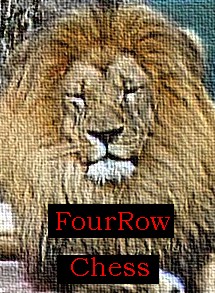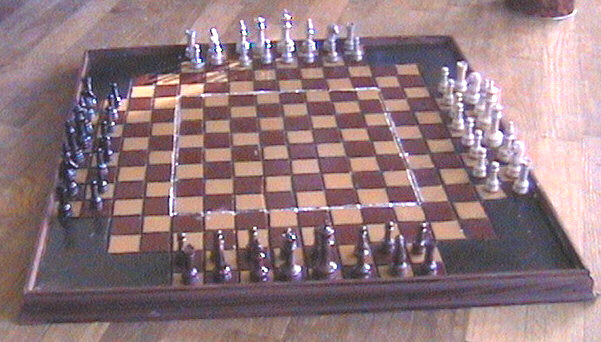Four Row Chess
Invented by Eric S. Clayton 1980
Text by Eric S. Clayton


Introduction
Four Row Chess is a game for 2 to 4 players.
Setup
See the above photo.
Oh, and for the curious...the silver outlined square in the middle is just for regular Chess play; it does not interfere or impact the playing of Q*chess.
Pieces
Standard Chess pieces are used.
- Knights can move in a regular "L" shape (3 up and 2 over) or in an extended "L" shape (4 up and 3 over). Thus a Knight can cover twice as many squares and make symmetrical or asymmetrical forks.
- Pawns can move 1 to 4 squares on the first move. En passant still occurs.
- A Pawn can change directions if it takes a piece coming from a direction perpendicular to it and can queen in that direction, unless it then takes in another direction and heads for a queen in that new direction.
- A Pawn cannot queen in the direction of it origin even if it is forced to serve a new King.
Rules
Four Row Chess follows the rules of chess with these exceptions:
- Play starts with the darkest set and proceeds to the right in turn.
- If a player is placed in check the play sequence is broken and that check must be answered immediately. Once it is answered play starts again to the right of the check answering player.
- The first two Kings checkmated will be removed from the board and their remaining uncaptured pieces will be forced to serve the checkmating King. If it is a team check where one different color piece is supporting the checkmating piece then the uncaptured pieces are divided equally, with the primary checkmating piece's player choosing first then the secondary and so forth. The relegated pieces are to be marked with different colored rubber bands to indicate whose army they belong to.
- Even if someone is playing as team mates or allies they cannot position themselves where their Kings can be put in check by allies. Or that check must be answered.
- In Four Row Chess the beauty is in the back and forth verbal negotiation that is going on. Verbally the players can agree to play as individuals, as teams of two, or agree to be 3 against one. Then you can verbally or non-verbally break old alliances at any time during the game or form new alliances by persuading another player to join you. This is when the treachery is at its height. Play continues and as the first two Kings are checkmated and taken off the board the spoils (uncaptured pieces) are divided, until there are only two players left with fairly large armies.
- The game ends when one of the final two kings is checkmated.
Playing Tips
Trust no-one, because they cannot be trusted
Equipment
See the above photo.
Credits
Copyright Eric S. Clayton 1980; all rights reserved.